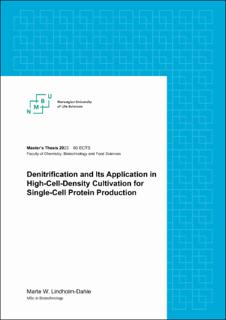| dc.description.abstract | Denitrification is one of the key processes in the nitrogen cycle, being responsible for the reduction of biologically available nitrate (NO3-) and nitrite (NO2-) to nitrogen gas (N2), with nitric oxide (NO) and nitrous oxide (N2O) as gaseous intermediates. Denitrification is an anaerobic process, and when denitrifying communities are exposed to oxygen, it tends to result in increased emissions of N2O. It is, therefore, essential to learn more about how oxygen fluctuations affect denitrification to find ways of mitigating the increasing N2O emissions. Denitrification can also be applied to industrial and biotechnological processes like protein production. With an increased population in the world, sustainable food and feed production is more crucial than ever, and with a shortage of proteins, new methods of producing them are needed. Single-cell protein (SCP) emerges as a tantalising prospect in this context. Existing culturing processes are based on aerobic respiration, however, with the limitations it entails, which denitrification might eliminate.
This thesis focuses on denitrification and its application in high-cell-density cultivation (HCDC) for SCP production through a newly invented process named AnaPro. The fed-batch culturing takes advantage of the alkalising effect of denitrification for the controlled provision of substrates. The process is still under development, and optimisations are needed: 1) As the culturing depends on a “pH-stat”, it is essential to consider the acidifying effect of CO2 produced by respiration. However, accurate measurements of this effect have been lacking. 2) Reactor systems may also be prone to oxygen leakages, and finding an organism which can tolerate potential oxygen fluctuations is required. In line with this, we tested the pH depression by CO2 at two buffer strengths in the presence and absence of cells. Moreover, we compared the model organism Paracoccus denitrificans and the presumably aerobic denitrifier Paracoccus pantotrophus in terms of their response to oxygen exposure during denitrification, taking parameters such as cell count, dry weight, gas accumulation, enzyme activity and yield into account.
The results of this work have contributed to optimising the anaerobic HCDC method. The relationship between CO2 and pH has been established, resulting in improved conditions for cell growth in a pH-stat. The comparative study of P. denitrificans and P. pantotrophus showed that the two organisms were highly similar, and neither showed signs of aerobic denitrification. However, subtle differences in yield and enzyme activity when exposed to oxygen during denitrification suggest that P. pantotrophus is a slightly better candidate for anaerobic HCDC than P. denitrificans. | |
